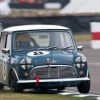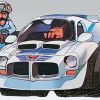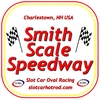Looks to be a Death Star motor.
Chris
Parma Motor ID ?
12 posts
• Page 1 of 1
Re: Parma Motor ID ?
It's definitely a 16-D. With the white endbell more that likely an older homeset motor. The normal 16-D's by Parma had pink endbell, and the Death Stars had a black endbell. :)
-

FootScoot - Mini Model Master
- Posts: 1655
- Joined: Wed Sep 05, 2012 8:18 pm
- Location: Evansville, IN
Re: Parma Motor ID ?
Deathstars also have the thinner, but stronger, S16D magnets. When set up properly, these older Parma 16Ds run quite well.
- bill from nh
- HRW SlotCar Veteran!
- Posts: 373
- Joined: Wed Sep 05, 2012 5:32 pm
- Location: New Boston, NH
Re: Parma Motor ID ?
FootScoot has it right, it's a Parma homeset motor. It's basically a standard 16D C-can and magnets with a slightly de-wound armature so it's more mild than a stock 16D. The arm can be swapped out for hotter options such as the stock arm or a balanced version that is even faster, you can change endbells and brushes and springs etc and get a pretty customized motor. :geek:
Bill is also right that with a little work (sometimes called blueprinting) these can run pretty well especially for home track use.
Or, you can buy Deathstar or other hotter motors and use them right out of the bag. ;)
Bill is also right that with a little work (sometimes called blueprinting) these can run pretty well especially for home track use.
Or, you can buy Deathstar or other hotter motors and use them right out of the bag. ;)
-

chappyman66 - HRW SlotCar Veteran!
- Posts: 1173
- Joined: Mon Sep 10, 2012 7:37 pm
- Location: SW of Mpls, MN
Re: Parma Motor ID ?
The home set arms would have more turns of a finer gauge wire than the 16Ds. A stock 16D arm is 70 turns of 30 ga. wire. I've been told the home set arms are wound with 140 turns of 34 ga., but I'm not sure these specs are correct. I was also once told they might be 80 turns of 32 ga.
- bill from nh
- HRW SlotCar Veteran!
- Posts: 373
- Joined: Wed Sep 05, 2012 5:32 pm
- Location: New Boston, NH
Re: Parma Motor ID ?
You can see by the crown gear, brass ferrule axle spacers, rear tires, steel chassis, and classic VW womp body that the car is from the late '80's era. I do not think what you've got there is the home set motor (it may not have been available yet). I believe the motor in the photo is the first 16D that PARMA sold in RTR commercial raceway cars that actually held up! I sold hundreds of them back in the late 1980's when I had my raceway. We ran them in midget, "mini-stox", "mini mods", stock womp and flexi-kar races.
I've still got a couple running in "play" cars. The endbell design (and probably an improved armature) is what put this motor over the top, in my opinion. The previous version was inferior in material and design, and had round (cylindrical) motor brushes that created a lot of heat. Between that and the cheap plastic endbell, I can remember the frustration of doing well in a race, only to have the car slowing about halfway through a race and eventually melting down to a standstill !!
The modern PARMA Deathstar and Super16D motor is superior in all ways -- armature, magnets, can and endbell design. They also have both lead wire tabs on top of the endbell.
If you notice in the photo, the white endbell motor has the old leadwire attachment tab arrangement - one on top, one on the bottom at the other side, same as the old Mura motors.
We used to put a small piece of vinyl tape on the chassis of the cars to prevent shorting to the bottom tab. I remember drilling holes through the can into the endbell and using small screws to keep everything secure. We also allowed racers to drill a 1/4" cooling hole in the old steel chassis, as there was none from the factory at that time. Providing that the commutator surface and can bushing both look to be in decent shape, you can hit that motor with some cleaner spray, install some new brushes, oil and fire it up.
I hope this helps you out, have fun with that womp! -- Ernie
I've still got a couple running in "play" cars. The endbell design (and probably an improved armature) is what put this motor over the top, in my opinion. The previous version was inferior in material and design, and had round (cylindrical) motor brushes that created a lot of heat. Between that and the cheap plastic endbell, I can remember the frustration of doing well in a race, only to have the car slowing about halfway through a race and eventually melting down to a standstill !!
The modern PARMA Deathstar and Super16D motor is superior in all ways -- armature, magnets, can and endbell design. They also have both lead wire tabs on top of the endbell.
If you notice in the photo, the white endbell motor has the old leadwire attachment tab arrangement - one on top, one on the bottom at the other side, same as the old Mura motors.
We used to put a small piece of vinyl tape on the chassis of the cars to prevent shorting to the bottom tab. I remember drilling holes through the can into the endbell and using small screws to keep everything secure. We also allowed racers to drill a 1/4" cooling hole in the old steel chassis, as there was none from the factory at that time. Providing that the commutator surface and can bushing both look to be in decent shape, you can hit that motor with some cleaner spray, install some new brushes, oil and fire it up.
I hope this helps you out, have fun with that womp! -- Ernie
- BIG E
- HRW SlotCar Veteran!
- Posts: 939
- Joined: Fri Sep 07, 2012 11:30 am
- Location: NY/Metro area
Re: Parma Motor ID ?
So....
I typed wrong, and Bill is right. The homeset motor has an arm that runs slower, probably due to more turns of smaller gauge wire. I guess I meant de-tuned and just messed up. Thanks for setting it straight.
It might be an early commercial motor, although I ran a bunch of rental cars at the raceway where I worked in the early 90s and they had that can and endbell design. In any event, it's an early and relatively mild Parma C-can 16D style motor. And there are plenty of parts available even if it doesn't run well. ;) You can even hot-rod them by pulling about 20-30 turns off each pole of the motor (though you sometimes go out in a blaze of glory, at least in my firsthand experience).
The bent frame might have been intentional.....it used to be a way to run larger rear tires and minimize the ground clearance to lower the cg without changing the stock bearing location (a typical rule in Womp racing). Of course, womps bend that way pretty easily anyway with a firm smack to the wall....so we would solder piano wire braces through there to stiffen them up. I always preferred to flatten them and run smaller tires when possible. They are plenty fun and inexpensive racing, even if you can't put nice scale bodies on them without cutting them up a bit.
I typed wrong, and Bill is right. The homeset motor has an arm that runs slower, probably due to more turns of smaller gauge wire. I guess I meant de-tuned and just messed up. Thanks for setting it straight.
It might be an early commercial motor, although I ran a bunch of rental cars at the raceway where I worked in the early 90s and they had that can and endbell design. In any event, it's an early and relatively mild Parma C-can 16D style motor. And there are plenty of parts available even if it doesn't run well. ;) You can even hot-rod them by pulling about 20-30 turns off each pole of the motor (though you sometimes go out in a blaze of glory, at least in my firsthand experience).
The bent frame might have been intentional.....it used to be a way to run larger rear tires and minimize the ground clearance to lower the cg without changing the stock bearing location (a typical rule in Womp racing). Of course, womps bend that way pretty easily anyway with a firm smack to the wall....so we would solder piano wire braces through there to stiffen them up. I always preferred to flatten them and run smaller tires when possible. They are plenty fun and inexpensive racing, even if you can't put nice scale bodies on them without cutting them up a bit.
-

chappyman66 - HRW SlotCar Veteran!
- Posts: 1173
- Joined: Mon Sep 10, 2012 7:37 pm
- Location: SW of Mpls, MN
Re: Parma Motor ID ?
No need to tare it down. They appear to be Parma home set cars. Many all so made it to the commercial tracks of the day. I still have several of them. They work great as is, or can be used as a base to make custom chassis to fit your favorite 1/32 scale model body. Just enjoy it and have fun.
-

DHansen - HRW SlotCar Veteran!
- Posts: 278
- Joined: Sun Sep 09, 2012 12:11 pm
- Location: Northern Iowa, USA.
Re: Parma Motor ID ?
Ya see... and people tell me they're embarrassed to admit they had actual FUN racin' womps! :>) -- Ernie
- BIG E
- HRW SlotCar Veteran!
- Posts: 939
- Joined: Fri Sep 07, 2012 11:30 am
- Location: NY/Metro area
Re: Parma Motor ID ?
Womp motors depend on the track. We run womps all year at our oval and use a variety of 13D motors in them, JK Falcons, Slick 7 MiniBrute, ProTrack Cheetah, TSR, and SRP.
-

smithspeedway - HRW SlotCar Veteran!
- Posts: 383
- Joined: Thu Sep 06, 2012 6:16 pm
- Location: Charlestown, NH USA
Re: Parma Motor ID ?
Motor choice for womps is all over the board. There is a ton of information out there about "blueprinting" which is basically optimizing the motor. DIfferent armatures (different windings/wire size/turns), longer/shorter armature stacks, commutator timing, different magnets, magnet strength and shimming, bearing and brush hood alignment, types of brushes and brush spring tension all are factors in the speed of the motor. As with many things in racing, how fast is related to how expensive. You can spend quite a bit of time and money on motors (don't ask how I know) and have no more fun that you might with a less expensive motor.
The so-called "sealed" motors (Pla-Fit Rabbit/Cheetah) are more akin to the motors found in the 1/32 scale cars. That doesn't mean they aren't fine for womps, especially if everyone uses a similar motor.
The most important thing is to pick a motor and enjoy running the car!
The so-called "sealed" motors (Pla-Fit Rabbit/Cheetah) are more akin to the motors found in the 1/32 scale cars. That doesn't mean they aren't fine for womps, especially if everyone uses a similar motor.
The most important thing is to pick a motor and enjoy running the car!
-

chappyman66 - HRW SlotCar Veteran!
- Posts: 1173
- Joined: Mon Sep 10, 2012 7:37 pm
- Location: SW of Mpls, MN
Re: Parma Motor ID ?
I can attest to the "fun" factor of the Plafit motors in a Womp chassis! We have a class at our local commercial track referred to as "Spec-Womp" in which the motor is specified as a Plafit Rabbit, pinion has to be a 9 tooth (crown is your choice - but everyone goes with a 26 tooth due to the size of the tracks) rear tires are limited to Parma 699 (normally a front tire on an FCR) and width is limited to 2.500" with a min chassis clearance of .050"
The racing is EXTREMELY close and a LOT of fun as it slows the cars down quite a bit and puts a lot of focus on tuning the handling and driver skill.
The racing is EXTREMELY close and a LOT of fun as it slows the cars down quite a bit and puts a lot of focus on tuning the handling and driver skill.
-

TuscoTodd - HRW Bouncer
- Posts: 7145
- Joined: Sat Aug 17, 2013 11:25 am
- Location: Rural Ohio
12 posts
• Page 1 of 1
Who is online
Users browsing this forum: No registered users and 2 guests
